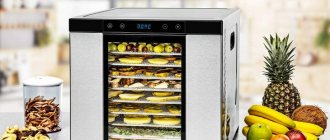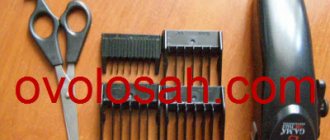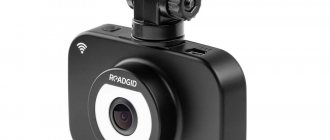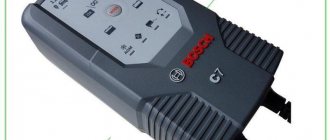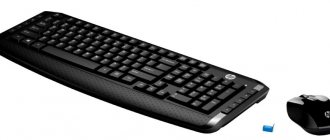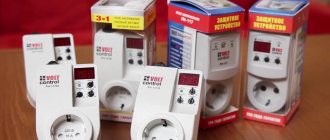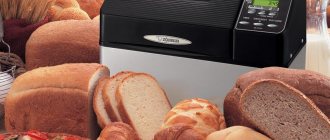Type
Manual - a device that must be held in your hands during operation.
Advantages: compact size, ease of use, low cost. Disadvantages - low power, limited operating functions. Stationary - this mixer has a special container and holder that are attached to a stand. Does not require additional human intervention in the operation of the device. Advantages – versatility, has many additional functions compared to a hand mixer. Disadvantages: bulkiness, difficulty in cleaning, high cost.
Advice: if the choice fell on a stationary mixer, then it is better to buy one that can also work in manual mode. Thus, it will be possible to combine both types in one device.
Combined - the design resembles a stationary model, but can also be used as a hand mixer if you detach it from the stand. The combined model combines the advantages of the two previous types of mixers.
Planetary (confectionery) - consists of a body with a motor, a kneading attachment and a bowl (bowl). This is a separate type of mixer, designed for large volumes of products, processing dense mixtures and all types of dough. The planetary model is equipped with a control panel and a timer.
A planetary mixer differs from other devices in that it produces double rotation: the nozzles around its axis and a platform with nozzles around the perimeter of the bowl itself. As a result, better mixing is achieved. Disadvantages: the highest price and large dimensions of the device.
There are three classes of planetary mixer:
- professional – intended for catering establishments;
- semi-professional – used by bars and cafeterias;
- household - used at home. This mixer is perfect for large families who prepare large volumes of culinary products.
Stand mixer
Hand mixer
How to choose a mixer for your home?
As we said above, a mixer is used to thoroughly mix one or more products; they are also good for making sauce, puree, and creams.
Mixer for home
When choosing a good mixer for the kitchen, it is worth having an idea about its types. Conventionally, devices can be divided into four groups:
- Manual;
- Stationary;
- Combined;
- Planetary.
Hand mixers
Hand Mixer
A hand mixer is a small body with buttons, from the base of which beaters extend. During operation, the mixer must be constantly held in your hand.
At the same time, the hand mixer is lightweight, you choose the cooking container yourself and can move with the device between work areas. It is also easy to store and fits in a kitchen cabinet.
What tasks can it handle? You can choose an inexpensive hand mixer for pancake dough, i.e. He can beat simple products - cream, eggs, butter. Will not cope with complex tasks, such as thick dough. Also, when choosing a hand mixer, consider the advantages and disadvantages:
Advantages:
- Easy;
- Mobile;
- Easy to maintain;
- Inexpensive.
Flaws:
- Low power (up to 500 W);
- Noise;
- The need for direct participation in preparation;
- Cannot solve complex problems.
Stand mixers
Stand mixer
A stand mixer is a body on which a bowl is installed and whisks are lowered into it. Due to this design, it is larger in size than the manual type. But at the same time, your participation in the preparation itself is not necessary, just press the button. In addition, when choosing a stand mixer, keep in mind that it has good power, which is enough to complete any culinary task - prepare stiff dough or unusually airy cream.
So, when choosing a mixer with a bowl, pay attention to its advantages and disadvantages:
Advantages:
- High power (400-700 W);
- Ability to cook different dishes;
- No need to participate in the preparation itself.
Flaws:
- Large weight and dimensions;
- Noise;
- The need to wash the bowl after each preparation;
- High price.
What to do if you can’t choose a mixer for the kitchen ?
Check out the combo model. In appearance it is difficult to distinguish it from a stationary one. This is the same body with a bowl, but if desired, the device can be detached and used like a hand mixer.
Planetary mixers
Planetary mixer
And the last type is the planetary mixer. It is distinguished by the presence of the function of rotating the nozzle around its axis and along the circumference of the bowl; kneading the dough or mixing any other products is perfect. In addition, by choosing a good planetary mixer, you will get the most powerful and fastest working device.
But let us immediately note that it is expensive. And it is better to buy it for those who really often prepare complex baked goods and other dishes. Some models will be equipped with a meat grinder as a bonus.
And, of course, when choosing a planetary mixer for your home , we take into account its pros and cons:
Advantages:
- High power;
- Reliability;
- Great functionality;
- Ability to withstand heavy loads and perform large volumes.
Flaws:
- Considerable dimensions;
- Noise;
- High price.
Power
The higher the power, the denser the mixture the mixer can process and the greater its productivity. At the same time, with increasing power, the cost of the device and electricity consumption increase.
Powerful mixers are often equipped with additional attachments that expand their functionality. The attachments are usually made of more durable material, which affects the price of the device.
First of all, you should decide for what purpose the mixer will be used. If this is whipping batter, cream, cocktails or soft products, then a power of 150-250 W . If you need to beat dense dough and similar products, it is better to choose a mixer with a power of 300 W or more.
When choosing a mixer based on power, consider its type. Recommended settings:
- for manual – 250-300 W;
- for stationary – 300-400 W;
- for combined – 250-400 W.
The maximum power of the planetary mixer can reach 2200 W.
What is meant by mixer power?
Lots of reviews, videos on choosing a mixer. The complete lack of indications of quantitative characteristics is surprising. Let’s say a television channel is conducting a test purchase of several mixers, and the devices are being tested. The cook announces the result. Often the difference between stationary and manual models is leveled out.
Out of ignorance, merchandisers say: more power for a mixer is good. In reality it is not like that. TV presenters cannot explain the difference. It is not clear how to determine the beating power of the dough.
Hand mixer
By physical definition, power is the speed at which work is performed. Due to high consumption of the mixer, it will not beat faster and will not knead the dough. There is a rev limit; you can't go any higher. The power will allow you to maintain the speed when the load increases (thick dough). Current consumption increases, heat generation on the motor increases. Now a specific example for housewives.
Let's take the hybrid mixers "Zelmer" series 481 (bowl included in the set). The working unit is removable and, when dismantled, turns into a hand mixer. The bowl is designed like this: it rotates due to a gearbox on the frame. The same engine is used. Power:
- Let's say the mixer is running at maximum speed in manual mode. Beat the whites for 2.5 minutes.
- We place the handle on the frame to maintain the same speed, the device will require more power. You will have to rotate the bowl and perform pendulum oscillations in the horizontal plane to evenly cover the area. Significant work per unit of time is power. The procedure time remains constant. A low-power blender would freeze midway, limited by its duty cycle characteristics.
In practice, this results in an entry in the operating instructions:
- maximum continuous operation in manual mode – 10 minutes;
- maximum continuous work on the bed – 3 min.
Stand mixer with bowl
The difference comes from power consumption. In manual mode, as conceived by the authors of the invention, the mixer does not show maximum consumption. Less heat is generated by the engine: the device can operate longer. As soon as you place the handle on the frame, the situation changes. Consumption is growing, heat is released (judging by the instructions) 3 times more.
If you look closely, you will see: the 481 series of mixers has slots on the body for ventilation. The engine is forced to cool (impeller on the shaft) - the device can operate for a long time without overheating. The dimensions of the motor are large: the specific power flow through the surface is less. Leads to an increase in useful time in the cycle.
Due to its size, we take a break for as much as 20 minutes. 3 minutes versus 20 when working on a bed. Break the rule - there is a high probability of failure. When choosing a mixer, look at the operating cycle characteristics. If the parameters suit you (3 min work – 20 rest) – we take it.
Body and bowl material
The body and bowl can be made of plastic or metal. The bowl is also made of glass.
- Plastic is inexpensive, lightweight, comes in a variety of colors, but is not as durable as other materials.
- Metal is durable and gives the mixer a solid look, but the cost of such devices is much higher. Also, the metal bowl is opaque, so it does not allow you to monitor the work process.
- Glass (for the bowl) is an environmentally friendly, durable material. Occupies a middle position in cost between plastic and metal. The most practical material for making a mixer bowl, but it is worth remembering about its fragility.
Bowl volume
The amount of product that can be prepared in one mixer cycle depends on this parameter. The volume of the bowl in different devices varies between 2-5 liters. As the volume increases, the cost and dimensions of the bowl increase. When choosing the optimal volume, find a balance between spaciousness and compactness.
You should focus on family size:
- for 2-3 people – 2-2.5 l;
- for 4-6 people – 3-3.5 l;
- for a large family (from 7 people) – up to 5 liters.
Planetary mixers have a larger bowl:
- professional – up to 140 l;
- semi-professional – 5-10 l;
- household - 3-7 l.
Important: when choosing the volume of the bowl, remember that it is not filled to the brim to avoid splashing of the contents. Thus, the working volume of the bowl will be 20-25% less than the nominal one.
How to choose a mixer
Hello, dear readers of the site Uspei.com. Can household appliances be redundant and unnecessary? Maybe. But it is not exactly. For example, a mixer. It seems that you can beat and mix the ingredients with a fork, or you can use a whisk.
But is it convenient? Definitely not. The hand gets tired, and the result is not always pleasing. Therefore, if any technique can be called unnecessary, then this is definitely not a mixer . We're talking about what to look for when choosing a mixer so that everything mixes well.
Deciding on the type of mixer
Criterion number one is to decide on the type of mixer. They can be manual, stationary and planetary. A hand mixer is the simplest story. The most compact, lightweight, inexpensive and easy to maintain. But the power in such mixers is usually low, and during cooking you need to hold it in your hand, and this is not always convenient. But you can whip it in any container.
advertising
A stationary mixer solves the problem of inconvenience. It doesn't need to be held in your hand. Throw in all the ingredients, select the desired speed and go about your business. By the way, this mixer does an excellent job of kneading hard dough and yeast dough.
A planetary mixer is the most efficient in operation. Here the nozzles and the bowl move. Nozzles around their axis and the entire circumference of the bowl. Due to this, whatever you put in the bowl, everything will be perfectly mixed in a short time.
advertising
But this type of mixer is suitable for those who often bake something. And if you want to go further, then take a closer look at models that are additionally equipped with a meat grinder, grater, and so on. Only an additional nozzle means additional money for it.
Do such mixers have any disadvantages? Of course have. Price. Size and weight. Noise. There are also advanced models, that is, stationary and manual in one bottle. At the touch of a button, a stationary one can easily turn into a manual one.
Power
Criterion number two is power. We have already talked about it indirectly, but now let’s go through the numbers. High power, of course, allows you to perform even the most complex tasks, but this also affects the cost.
See also: Philips TVs Performance 7300 series
So, for a manual one, 350-400 W is enough. There are, of course, more powerful models - 500, 600, and there are also less powerful ones - 180 W. But the golden mean in this case is just what is needed. It is also suitable for beating soft products and for kneading dough.
advertising
A stationary one needs more power - 500 W. And the planetary one is 600 and above. Especially if you need a mixer for production purposes.
Speed
Criterion number three concerns speeds. As a rule, there can be from 3 to 10 , although you can also find models with 16 speeds. The question is, does a mixer need 16 speeds? Even with 5 you can solve all everyday problems. But everyone has different needs.
Material
The fourth criterion is material. And here we will talk about stationary and planetary mixers, because we will talk about bowls. The vast majority of mixers have a plastic body. The simplest and most affordable option for a bowl is plastic . But over time, this option may change color and become deformed. However, a decent amount of time should pass this way, if, of course, the plastic is of high quality.
Metal certainly looks more presentable and practical. Such bowls do not change color, do not deform, and are unlikely to be damaged. But plus to the price.
advertising
And the third material is glass. This option is suitable only for those people who have straight arms.
Bowl volume
The fifth criterion is to continue the theme of bowls and look at their volume. It is important to remember that when choosing a mixer, you should take into account the fact that you will not load the bowl completely, because you risk staining everything in the kitchen. You should always have 1/4 of the volume left .
advertising
Based on this, if you are cooking for one or two people, then a 2-2.5 liter bowl will be enough. If for three to five - then 3-5 liters. It would also be nice to have a special lid through which you can add ingredients.
Nozzles
Criterion number six – nozzles. And here I must admit that in my understanding a mixer is a device with two whisks and that’s it. Okay, another hook for tough dough. But manufacturers go further and offer a blender, a chopping knife, a sieve, a shovel, a puree attachment, and a plastic disc for mixing thick dishes.
See also: Bagless vacuum cleaners Bosch BGC2UK2000, BGS2UPWER1 and BGS2UCHAMP
In general, there is plenty to choose from . The main thing is that these nozzles are made of high-quality wear-resistant material. Plastic ones are easily deformed, but metal ones serve faithfully for many years.
Let's sum it up
If you do not plan to cook complex dishes, opt for manual cooking. If you often make confectionery products on a large scale, then planetary ones are your choice. If you cook often and don’t want to be tied to a mixer, then a stationary one.
It’s better not to skimp on the volume of the bowl , because today you have a family of two people, and tomorrow of three. As for the attachments, it all depends on what you plan to cook. Well, as for the speeds... Honestly, I don’t see the point in paying more for devices that have 7 or more speeds. But maybe there is something wrong with my vision.
advertising
Write in the comments how many speeds do you need from the mixer? Do you cook often? I hope that our tips will be useful to you. Don’t forget to look at our other reviews, and then you will always have only the best helpers at home. It’s clear, yes, what I’m talking about household appliances?
Tags: household applianceskitchen
We are on social networks:4
Nozzles
Whisks – two attachments for whipping cream, eggs, cream and other liquid products. Corollas are presented in two types: a wire frame (in low-power devices) or a design with metal blades (in powerful models). Practice shows that the second type is characterized by greater functionality.
The blender attachment is a special attachment with blades, protected by a cap to avoid splashing. Very convenient for preparing sauces and vegetable purees for children.
For purees - a disc attachment. Makes it possible to prepare homogeneous mousses, sauces from vegetables and fruits, and purees.
For dough (hooks) – these are two attachments in the form of spirals. Designed for mixing and beating thick dough.
A container with a chopper is a bowl with knives at the bottom. Designed for producing minced meat, chopping herbs, cheese and other harder products.
Electric knife – used for cutting vegetables, bread and other products.
Sieve attachment – used for wiping berries, sifting flour and other similar works.
The main attachments are whisks and hooks, which beat liquid products and knead thick dough. The presence of other attachments increases the price of the mixer, which is not always justified, since in some jobs they are simply not needed or duplicate the function of other household appliances. This applies to a blender attachment or a universal chopper if the kitchen has a separate blender with the appropriate equipment.
Attachments for planetary mixer : whisk, hook, paddle (bitter). The spatula is designed for preparing various fillings and glazes. In addition, the delivery package may include other attachments that expand the capabilities of the planetary mixer (functions of a juicer, meat grinder, vegetable cutter).
Important: the nozzle comes into contact with products, so the quality of the metal must be high.
Modes
Turbo mode – brief acceleration of the movement of knives or attachments. Usually switched on at the end of work to quickly complete grinding or mixing of products
Bowl rotation – allows you to mix products more evenly, this mode is typical for stationary mixers, the bowl rotates thanks to a special automatic drive.
Impulsive mode – allows you to work with short breaks. Particularly useful for crushing hard foods such as ice and cheese.
Slow start – mixes ingredients smoothly, avoiding splashing of the contents of the bowl.
Additionally
The number of speeds affects the functionality of the mixer. For hand mixers, the number of speeds is in the range of 2-16, for stationary models – 2-10. The more speeds, the more accurately the optimal speed of rotation of the nozzles for different products and jobs is selected. At the same time, a large number of speeds increases the price of the mixer.
Most often there are mixers with 3-6 speeds. This is the “golden mean” between comfort and functionality: decreasing or increasing speeds will make work difficult, and in addition, in practice, an excessive number of speeds is useless.
Weight matters when choosing a hand mixer: when working with a heavy device, your hand will quickly get tired.
Cable length should not be less than 1 m (there are cords 1.8 m long). A shorter wire will make the device more difficult to use. When choosing the cable length, proceed from the location of the outlets in the kitchen.
Meals are available in two options:
- from the mains - the most common solution, its disadvantage is the dependence on the outlet, which makes it difficult to work with the device;
- from a battery - does not have the disadvantage of the previous option, but at the same time the cost and weight of the mixer increases, and the operating time is limited. Therefore, powerful models operate from the network.
The number of slots for attachments (for a planetary mixer) varies between 1-4. In practice, 1-2 is enough.
Mixer head rotation speed
Different dishes require a different approach. Concerns the mode (implementation is possible in a stationary robotic mixer), the speed of rotation of the nozzle. The creator of the mixer emphasized: the wire paddle moves slowly so that the air has time to penetrate into the thickness of the protein. High revs are not needed.
Mixer speed adjustment
It’s good if the kit comes with a recipe book with an example of how to use the available speeds. It will be more difficult if you buy a Moulinex mixer: the instructions cannot be downloaded. Using bread machines as an example, they showed the solution to the problem. If problems arise, please contact the appropriate section of the “VashTechnik” portal. At the same time, learn how to bake bread.
For hand mixers, search for instructions on the manufacturer’s official website:
- Category – Food processors.
- Subcategory – Hand mixer.
Equipment
Overload protection - automatically turns off the mixer when overheated and prevents damage to its motor.
The protective cover on the bowl prevents the contents of the bowl from splashing. Often this lid has a hole for adding food during cooking.
Accessory release button – makes it easier to change attachments.
Rubberized handle prevents the mixer from slipping out of wet hands.
Bowl rotation – provides double rotation: the nozzle around its axis and the bowl itself. This function turns a stationary mixer into something like a planetary model, with the difference that it is not the bowl that moves, but a platform with attachments. As a result, the process is accelerated and more uniform mixing of the product is achieved.
Wall mounting - saves space on the work surface. This feature is useful if the device is often used and needs to be at hand.
The control panel (for a planetary mixer) can be mechanical or touch. The mechanical panel is more durable, the touch panel is more convenient, easier to maintain and more impressive in appearance.
Cord compartment – ensures uniform winding of the cable and protects it from fractures and kinks. Such a compartment will be needed if the cable is long or the mixer is rarely used.
A device for storing attachments is a compartment or stand that makes it easier to store relevant items. Additionally, the compartment or stand reduces the chance of losing the attachment.
Which mixer is better to choose: overview of varieties
Handheld, stationary or planetary – which mixer should you choose for your home? Let's consider the advantages and disadvantages of all three options and choose the optimal one.
Manual
Great for churning liquids or small amounts of mixture. They use little electricity and are easy to operate. More often in a set you can find one or two attachments.
Advantages:
- Low price.
- Lightweight and compact.
Flaws:
- Low functionality and power.
- When whipping, your hand may get tired.
Stationary
Such devices do not require intervention in the churning process. You just need to put the food in the bowl, insert the attachment and turn on the mixer.
Advantages
:
- Good power.
- There is a rotating bowl.
Flaws:
- Heavy.
- Noisy.
- The cost is too high.
Planetary
The name of the device comes from the principle of operation. The nozzle begins to rotate around its axis and around the circumference of the container. The mixture or liquid is churned perfectly.
Advantages:
- Performs the functions of a meat grinder and slicing.
- Very reliable and powerful.
- Process products quickly.
Flaws:
- They make a lot of noise when working.
- They are expensive.
CASHBACK 800 rub. on Wildberries!
From now on you will receive real cashback up to 800 rubles. on Wildberries when purchasing products from the list!
PRODUCTS WITH CASHBACK
Manufacturer
It is not recommended to purchase mixers Delfa, Elenberg, Saturn, West, Aurora, Hilton, Liberton, Maestro, Maxwell, Mystery, Polaris, Sinbo, Steba, Supra, Viconte. These devices are usually poorly assembled, made of cheap plastic (often smelling unpleasant) and cannot withstand prolonged loads - they can quickly burn out. Many brands do not provide high-quality warranty repairs; there is a high probability of buying a defective product.
More expensive mixers are Clatronic, Ariete, Fagor, ProfiCook, Russell Hobbs, Zelmer. They are definitely of higher quality: the beaters break much less often and the engine burns out. In general, the devices are more durable in operation. It should be noted that in no case is it recommended to exceed the continuous operating time specified in the user manual, otherwise the mixer may burn out.
The best manufacturers can be considered AEG, Bosch, Delonghi, Panasonic, Philips, Tefal, Gorenje. These are brands of household appliances that have already gained a high reputation. Mixers of these brands are made of durable materials, well assembled (for example, the whisks are easily inserted and do not play), are often equipped with additional bowls and attachments, and operate relatively quietly. It should be noted that the price range of this group is large: very often the cost of such a mixer is comparable to the price of products from the second group.
The most expensive mixers are Bork. However, the price of this equipment is extremely high due to the design. It cannot be classified as a premium class due to inadequate quality.
